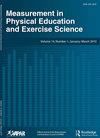Within- and Between-Session Reliability of Corticospinal Excitability in the Upper Extremity
IF 1.9
4区 教育学
Q2 EDUCATION & EDUCATIONAL RESEARCH
Measurement in Physical Education and Exercise Science
Pub Date : 2022-04-26
DOI:10.1080/1091367X.2022.2070434
引用次数: 1
Abstract
ABSTRACT Reliable techniques to assess centrally mediated function in healthy individuals are essential to understand the origins of neuromuscular dysfunction in pathologic populations. This study examined the test–retest reliability of corticospinal excitability in the upper extremity musculature of 21 healthy individuals using transcranial magnetic stimulation. Within-session reliability was assessed by comparing tests performed 120 minutes apart. Between-session reliability was assessed by comparing the second (24 hr), third (1-week), and forth (2-week) sessions to the first test. We recorded active motor threshold (AMT) and motor evoked potential (MEP) at 120% AMT of the upper trapezius (UT), middle deltoid (MD), and flexor carpi radialis (FCR) bilaterally. Intraclass correlation coefficients (3,1) were used to assess relative reliability, and minimal detectable changes at 95% confidence level were calculated to assess absolute reliability. Our results suggest that AMT of the MD and FCR demonstrated acceptable within-session and between-session reliability over 24 hours, with all muscles evaluated ranging from moderate to good over 2 weeks. In contrast, MEP amplitudes were less reliable for all muscles, with reliability point estimates ranging from poor to moderate. AMT appears to be a more consistent measure of corticospinal excitability in upper extremity musculature, which may be more appropriate in clinical outcomes research.上肢皮质脊髓兴奋性的会话内和会话间可靠性
评估健康个体中枢调节功能的可靠技术对于了解病理人群中神经肌肉功能障碍的起源至关重要。本研究考察了21例健康人经颅磁刺激上肢肌肉皮质脊髓兴奋性的重测可靠性。通过比较间隔120分钟进行的测试来评估会话内可靠性。通过比较第二次(24小时)、第三次(1周)和第四次(2周)与第一次测试来评估两次测试之间的可靠性。我们在双侧上斜方肌(UT)、三角肌中部(MD)和桡侧腕屈肌(FCR)的120% AMT处记录了活动运动阈值(AMT)和运动诱发电位(MEP)。类内相关系数(3,1)用于评估相对信度,计算95%置信水平下的最小可检测变化来评估绝对信度。我们的研究结果表明,在24小时内,MD和FCR的AMT在疗程内和疗程之间表现出可接受的可靠性,所有肌肉在2周内的评估范围从中等到良好。相比之下,MEP振幅对所有肌肉的可靠性较低,可靠性点估计范围从差到中等。AMT似乎是上肢肌肉皮质脊髓兴奋性的更一致的测量,这可能更适合临床结果研究。
本文章由计算机程序翻译,如有差异,请以英文原文为准。
求助全文
约1分钟内获得全文
求助全文
来源期刊

Measurement in Physical Education and Exercise Science
Medicine-Orthopedics and Sports Medicine
CiteScore
4.20
自引率
33.30%
发文量
24
期刊介绍:
The scope of Measurement in Physical Education and Exercise Science (MPEES) covers original measurement research, special issues, and tutorials within six substantive disciplines of physical education and exercise science. Six of the seven sections of MPEES define the substantive disciplines within the purview of the original research to be published in the journal: Exercise Science, Physical Activity, Physical Education Pedagogy, Psychology, Research Methodology and Statistics, and Sport Management and Administration. The seventh section of MPEES, Tutorial and Teacher’s Toolbox, serves to provide an outlet for review and/or didactic manuscripts to be published in the journal. Special issues provide an avenue for a coherent set of manuscripts (e.g., four to five) to collectively focus in-depth on an important and timely measurement-related issue within the scope of MPEES. The primary aim of MPEES is to publish high-impact manuscripts, most of which will focus on original research, that fit within the scope of the journal.
 求助内容:
求助内容: 应助结果提醒方式:
应助结果提醒方式:


